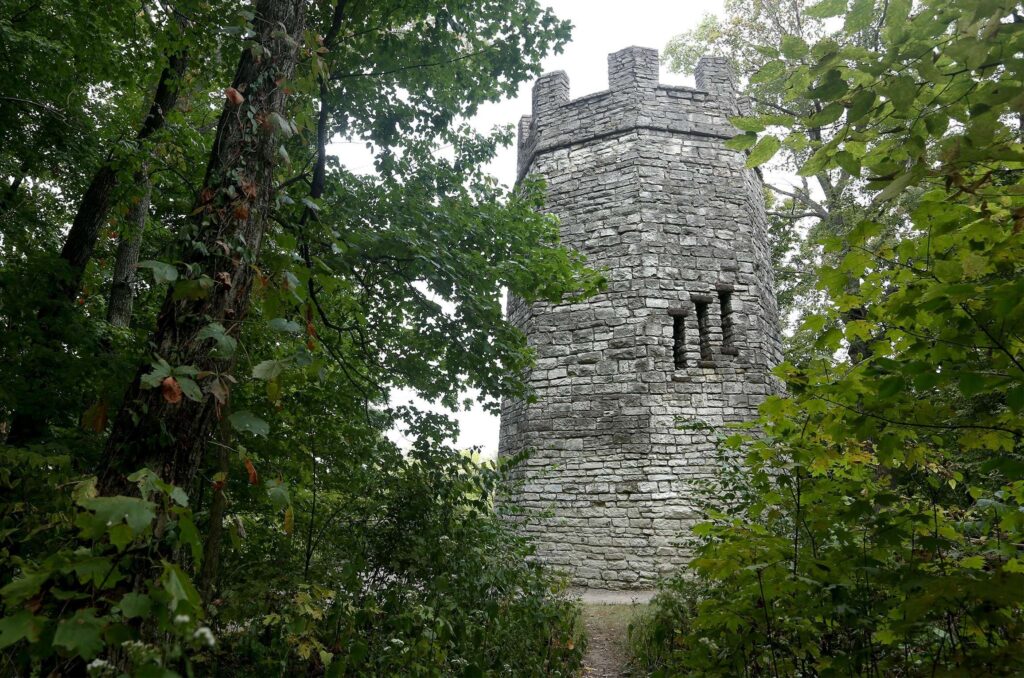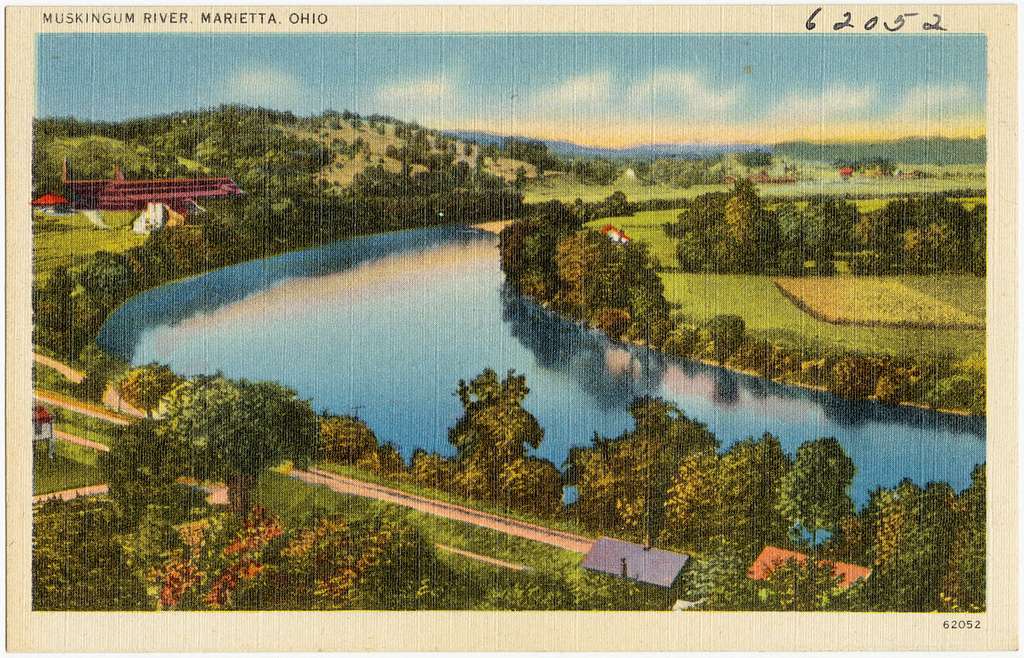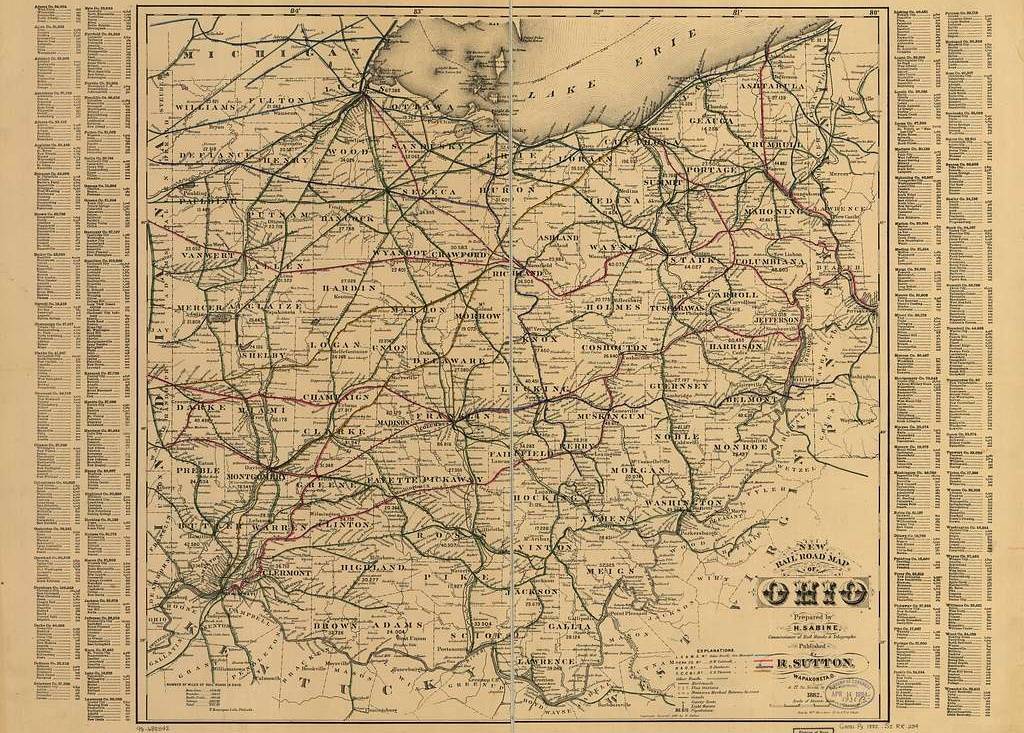When you start looking into the myths and legends of Ohio, you’re probably going to hear about the Dayton suburb of Kettering. Did you hear about the ghost of The Witch’s Tower? Have you seen Frankenstein’s Castle? Don’t go near the Patterson Tower at night, alone. The Hill and Dales Tower is haunted by a teenage girl. The Kettering Stone Tower … The Lookout Tower …
You’d probably start to think that Kettering has quite a few haunted castle towers, except for one tiny thing – they’re all the same thing.
According to some, the tower was built during the Civil War and the wife of a soldier climbed the tower after learning of her husband’s death and leaped to her death. Other legends tell about a coven of witches that moved in and did “witchy” things like dressing up like Bette Middler and sucking the life out of children to regain their youth. Or, the place is haunted by the ghost of John Henry Patterson, the guy who founded The National Cash Register Company who lived near the area and wanted a place to haunt, I guess. (Hey, not all legends are all that well thought-through.)
The only legend that may hold some portion of truth involves the ghost of a girl who had tried to take cover in the tower with her boyfriend during a thunderstorm, only to be struck by lightning and killed on the spot. Some versions of this tale say the boyfriend was also hit by the lightning, too, so now the ghostly couple roams the grounds. But, we’ll get back to this one in a bit. First, let’s see if we can figure out where, when, and how the tower was built in the first place.
The National Youth Association
The National Youth Association was an agency founded by Franklin D. Roosevelt (as part of his New Deal) whose purpose was to help Americans between the ages of 16 and 25 find employment or educational opportunities. It started off being a part of the Works Progress Administration from 1935-1939 and even had a division of Negro Affairs. After then, it was transferred to The National Security Agency, and in 1942 it fell under the War Manpower Commission until it was discontinued the following year.
In July 1939, the head of the National Youth Association, Aubrey Williams, was visiting the Cincinnati area to inspect a few of the projects that were going on. All were deemed a success. While he was here, one day he was joined by Brenda Tracey, the NYA supervisor for Montgomery County, on a trip to Dayton where, among other things, they announced a new project – a stone tower looking over the Community Country Club in Hills and Dales. At that time, there were over 160 boys and girls working on NYA projects in Montgomery County, and she expected over a hundred more within the next few weeks.
It’s important to note here that this is the time period right after The Great Depression when the nation was still trying to pick itself up and there really weren’t all that many opportunities for young adults trying to escape poverty.
The Lookout Tower was to be an NYA project to provide the residents of suburban Dayton with a tower overlooking the country club. Project managers also said they were going to use leftover materials bound for disposal, such as leftover rocks which remained after old houses had been demolished, and leftover lumber from a number of bridges that had been built in the area.
The following year, after several weeks of labor, the stone tower opened to the public. Anyone visiting the park could climb the 40-foot structure and from what I hear, the view was amazing.
The Incident on May 17, 1967
By the mid-1960s, The Lookout Tower was a fairly popular place among the Dayton area youth. There had been a number of cases involving minor vandalism or fights between slightly inebriated youth. The Park District was starting to think that the tower had outlived its usefulness and were considering taking it down. At one point they had boarded up the doorway, but it wasn’t long before someone opened it back up again. After this, they installed a metal grate to cover the entrance, leaving it open during the day but locking it at night. They were keeping an eye on the place, trying to figure out what to do.
Then, on the evening of May 17th, 1967 – an event occurred that would begin to change things for good at the Lookout Tower.
Laurel Pearson was walking through the park when he heard sounds of distress coming from the Lookout Tower. He was the first to find Ronnie Stevens laying in the tower’s doorway, writing in pain. Eleven steps up toward the top of the tower lay an unmoving female, Peggy Harmeson, covered with first, second, and third degree burns. Within seconds, Pearson was joined by two girls who had also been walking in the park. These two girls ran to the police department and reported what had been found.
At first, it wasn’t entirely clear what had happened. Harmeson’s body was so covered in bruises, scrapes, and burns the initial officers on the scene weren’t entirely certain what had happened. There had been a violent thunderstorm in the area earlier that evening that had produced lots of lightning, so further investigation produced the only logical result. Police now believe that the couple had been at the top of the tower when the storm rolled in. Perhaps a bit too late, they were descending the tower’s staircase when the metal railing outside had been struck by lightning. The girl must have taken a stronger jolt, and likely died immediately after the strike. The boy was also struck, but he was lucky to survive with his life.
After the death of one young lady and the serious injury of a young man, John J. Somers, head of the Department of Parks and Recreation once again called for the building to be demolished. He promised he would do that if the tower didn’t stop being used for things other than its original intended purposes. (In other words, if the kids didn’t stop drinking and vandalizing it, it was going to go away.)
Considering that the entrance to the tower is now blocked by a slab of cement, it’s probably not all that hard to figure out what happened.
The Witch’s Tower and Frankenstein’s Castle Today
When you take a look at the written reports of a “Witch’s Tower” or “Frankenstein’s Castle” in Kettering, Ohio – it’s important to remember that they were all being told in a time when searching through countless years of newspaper reports was hard work and when asking someone if they had searched the internet would illicit a response like, “What the heck’s the internet?”, considering it hadn’t exactly been invented yet.
The earliest mention I found of a “Frankenstein’s Tower” appears to date from the late 1940s, just a few years after the tower had been built. A version of the ghost story of a civil war widow jumping from the top of the tower dated shortly after that. For me, it seems odd they would surface so quickly after the structure was built, but it was a different time back then.
Still, I have to wonder where the “Witches Tower” or “Frankenstein’s Castle” came from…?
I think it’s pretty obvious why some people want to call it Patterson’s Tower. John Henry Patterson, the founder of NCR, The National Cash Register Company, was from that area, and a nearby street was named in his honor. If you didn’t know – Patterson and his company changed the world in ways you might not realize at first.
The National Cash Register Company was set up in 1884 after Patterson (and his brother) bought the patient rights to a device created by James Ritty called a Cash Register. This would revolutionize the world of retail sales. Later on, the focus of the company would expand a bit, using its technology to create code-breaking machines (which the military would utilize), and even later than that would play some role in the development of personal computers.
In case you didn’t know, there had always been a rivalry between NCR and IBM, which stemmed from that time when NCR fired a man named Thomas J. Watson, Sr., who went on to create a little company called Computing-Tabulating-Recording Company, which was later renamed International Business Machines or IBM. But, that’s maybe a story for another day.
Needless to say, Patterson was a major figure in the history of Dayton. A statue dedicated to him still exists not far from the tower, and a nearby road was named after him. Therefore, it’s not hard to figure out why people would want to associate the tower (or one of its supposed ghosts) with him.
Nobody is entirely certain where the “Frankenstein’s Castle” or “Tower” came from, but my theory is that it came from the movies. Throughout the 1930s and 40s, there was a new type of “horror” film that seemed to be changing the theatrical experience. Among these was the Universal Frankenstein series, starting with Frankenstein in 1931 and The Bride of Frankenstein a few years later. After many successful films, the series would ultimately end in 1948 when the titular monster met Abbott and Costello. (Yes, there were other Universal monsters, like The Invisible Man, and Dracula, among others.)
The observation tower was built at a time when these films were dominating the theaters, and it’s not hard to see why someone would think this castle was something out of these movies.
The earliest reference to a “Witch’s Tower” that I discovered came from the early 1980s. And that date might provide a clue as to where that name came from. The late 1970s through the 80s was a period of time we sometimes refer to as The Satanic Panic. On the one hand, you had religious organizations and churches preaching about the devil in new ways. Then you had the rise of a certain brand of counterculture that led to The Church of Satan rising in popularity, with demonic themes appearing everywhere from popular movies to rock and roll (and heavy metal) music. Soon, cases of “Ritual Satanic Abuse” were spreading across the nation, and peace-loving occultists began appearing on daytime television talk shows … let’s just say it was more “Panic” than truly “Satanic”. (And yes, when looking at modern groups like QAnon, I’ve realized this never really went away.)
So, stories of the tower being associated with Witchcraft during this period are probably to be expected.
The Lookout Tower still stands today, although it seems like it’s just a shell of its former self. Maybe at some time in the near future, the structure will be repaired, and maybe even reopened to the general public. If you plan to go and visit today, you’ll find barricades surrounding the place (and the entrance is still blocked with concrete, so there’s that, too.)
But, from time to time, people swear they see ghosts around the place, and you can still find plenty of Ghost-Hunter videos online, too.
All in all, I can’t say that right now The Lookout Tower is worth visiting on it’s own. However, the park it’s in does have quite a few attractions worth checking out. You can have lunch at the Paw-Paw Pavillion … or take a hike on one of the many trails … and since I mentioned it before, head north a bit and check out the Patterson memorial.



